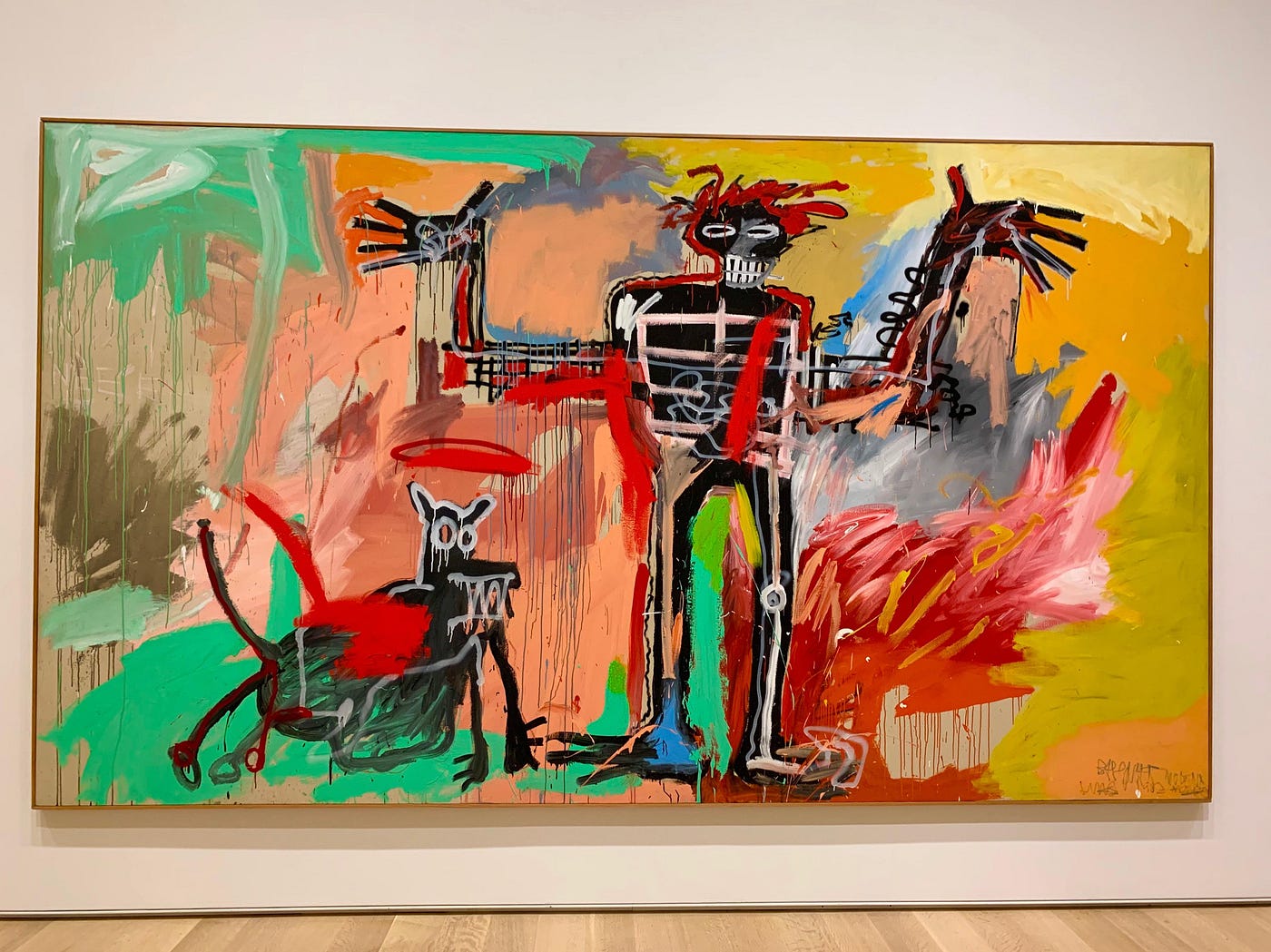As I’m writing this, the floor price for buying a Bored Ape Yacht Club NFT hovers around 73ETH, or about $185k. That’s pretty wild for a jpg of a cartoon ape that by many accounts isn’t exactly high art. Depending on who you ask, Bored Apes are either a glimpse of the future or a scam, or both. Why are people willing to pay nearly a quarter of a million dollars for a digital picture of a monkey?

Detractors argue that NFTs in general have little value for a variety of reasons: you can copy images infinitely so there’s no scarcity value; you’re just buying a pointer to an image and you actually own nothing because it’s not stored on-chain; blockchains themselves are immoral both from an environment footprint and because they introduce artificial scarcity to computing, which has a heralded ability to reduce the marginal cost of an additional copy of something to zero; and so on.
One relatively superficial objection is that it takes less talent and virtuosity to create an NFT (or, specifically, something that looks like a Bored Ape) than it does the Mona Lisa, but (a) modern forgeries are virtually indistinguishable from the genuine item (and that’s why people pay so much at Christie’s–for validation of provenance and ownership history — hey, wait a second, that sounds familiar!), and (b) artistic technical ability is by no means a guarantor of success or value in a work of art. This is true across art types: there are plenty of virtuoso guitarists, bassists, and drummers who are only modestly commercially successful and marginally influential outside of a small group of cognoscenti, and conversely there are plenty of far less technically accomplished musicians who are substantially more commercially successful and culturally impactful.
So, instead of refuting general reasons why NFTs are not valuable, what are some reasons Bored Apes specifically are valuable?
One could hand-wave about how a Bored Ape is a unique pass to be a member of an exclusive club, but that’s slightly missing the mark. The same would be true of a Soho House or Equinox membership, but those aren’t worth quite as much. Sure, you could make an argument that the number of Bored Apes is limited; but first of all, it’s not: they’ve also launched dogs, Mutants, and more may be on the way to create different tiers or sub-communities. And second, the number of Soho House or Equinox members is also limited, in practice, by the number of physical club locations (and the yield function of how often people go in; if it gets too crowded, membership loses value and members churn). So, limited supply of memberships on its own isn’t a complete explanation.
On top of that, the current utility of a Bored Ape real-world club membership is quite limited. All there is (known) right now is a series of periodic in-person events and the promise of a real-world clubhouse in the future — nowhere near the utility one would get from a worldwide series of members’ clubs like those operated by Soho House or Equinox. Bored Ape members are paying for membership significantly based on the expected value of this future utility — and the future utility of being part of a members’ club, no matter how exclusive, isn’t that high (especially when you consider that the most well-known members of the club may not ever show up). Even if you apply a probability-weighted discount factor, no one’s paying $250k for the mere attenuated possibility that someday they might be in a room with Steph Curry, Post Malone, or Justin Bieber. (If that’s what you really want, there are cheaper and more direct ways to do that — especially if you’re Justin Bieber himself.)
The balance of the value people are paying for derives from the social signaling value of owning a Bored Ape. In other words, “how much am I willing to pay to claim the social cachet that would accrue to someone who has this asset associated with their identity?”
A piece of art is worth millions of dollars not because it has any objective empirical functional value (it doesn’t necessarily create a stream of cash flows for the owner), but because that’s what people collectively believe it’s worth. That worth could be constructed out of the emotional impact of a given work, its historical importance and influence, its rarity, or simply the fact that one wealthy person wants to signal to other people that s/he has specific taste or values or has achieved a certain level of wealth.
Art across the wealth spectrum and across formats performs this function. It’s why people wear concert t-shirts or buy band posters, or even buy custom assets in CS:GO or Fortnite: they’re signifiers that advertise to other people the owner’s values and personal tastes. High-end cars and fashion are the same thing: part utility for the owner, part signaling to an audience.
Two factors that define the social signaling value of art are the size and the relevance of the audience to which one can signal. For example, if you own a Lamborghini, that has limited value because only people who see you driving it (and who can identify you while doing so) witness and take in that social signal. Fashion is similar: largely limited by line of sight and the people in your immediate vicinity. However, if that audience is well-targeted to be other people you care about impressing, who share your values and would be suitably impressed by such a display — say, at the Met Gala — the investment in the objects and their display makes social economic sense. Your display isn’t just visible to the people at the party, but to everyone who consumes the memes syndicated from that party via the media.
This is, obviously, how advertising works: people pay to have their idea viewed by an audience that’s likely to be receptive to it. The better targeted the audience, the more an advertiser is willing to pay per impression. Most of the ideas being commercially advertised are “your life would be better if you bought this thing” but there’s no reason you couldn’t just advertise “witness me” or “I am fashionable” or “I am generous” and so on. This is exactly why NFTs are uniquely interesting: they take a previously physically limited audience and virtualize it while maintaining the link to the owner’s identity. They remove physical barriers to memetic spread and enable identity projection at the speed of the internet.
Visual art is the closest analog to NFTs. On one end of the spectrum, art is extremely private, only being witnessed by visitors to one’s home, but at the other end its public exhibition performs a noblesse oblige function for the person who owns it. Take, for example, Ken Griffin’s numerous contributions to the Art Institute of Chicago. Wealthy people can afford to buy highly-regarded pieces of art and share them with the public. That art, on display, is often (but not always) tagged with the collection whence they came, reminding the viewer of both the owner’s wealth (that they can afford to own this) and their generosity (that they make it available to everyone). You can look at, say, Basquiat’s Boy and Dog in a Johnnypump at the Art Institute and immediately connect that piece of art to Ken Griffin.

This isn’t a purely cynical ploy, though. Think about how much more it means to see a concert with your friends than alone. There’s an element of truth to it giving people pleasure to share things one values with other people, as a means of perpetuating the meme that thing represents. But for art that’s limited in supply — like a unique Basquiat — having more people experience it can increase its value: the spread of the meme increases the value of the authentic original object.
NFTs are like that but on a grander scale. Instead of being limited to the people on the sidewalk or the people visiting an art gallery–which are somewhat strict physical real-world limits–anyone with an internet connection can see that, yes, this is the genuine item, and it’s owned by this particular person. The audience size for your social signal has gone way, way up, and if your NFT is part of a collection that has high memetic value — as Bored Apes have very much captured the zeitgeist of the first wave of NFTs — then the value of your signal isn’t just a single idiosyncratic jpg, but a whole cultural moment.
How much is that worth — the ability to broadcast to the connected world your participation in (and contribution to, by way of building the community of) a cultural movement that could be as important as pop art, Studio 54, and the internet revolution rolled into one? Upwards of a quarter of a million dollars to some people.
And in the grand sweep of history: doesn’t that sound cheap?